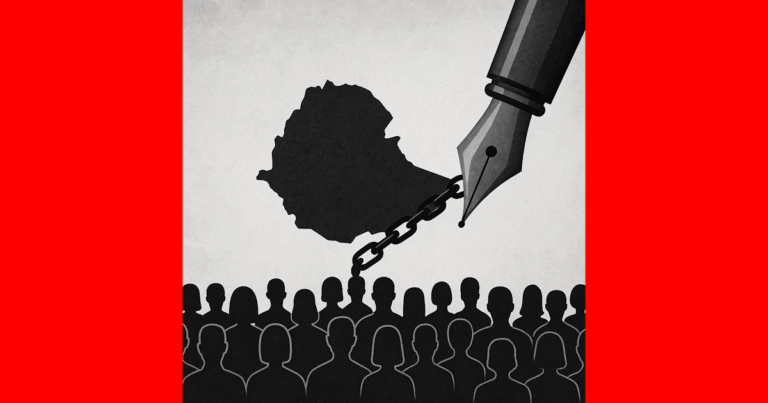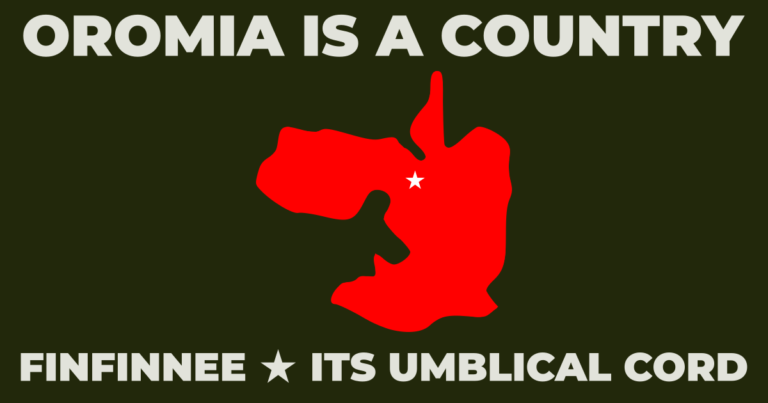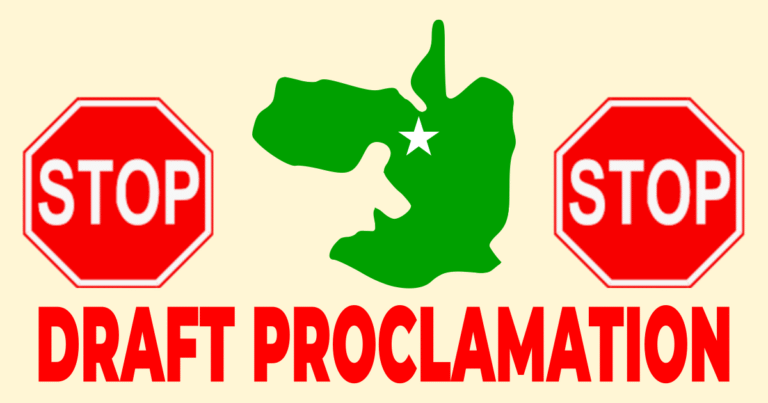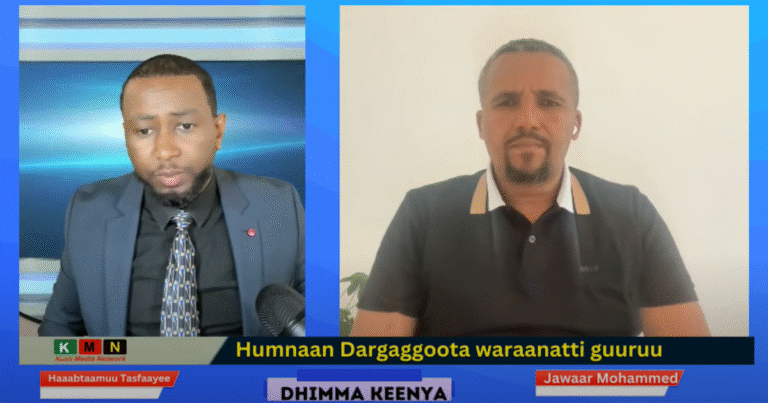The History and Politics of the Qubee Alphabet
Guluma Gemeda Professor, PhD
1 July 2018
In several publications, Professor Mekuria Bulcha has presented the origin, development and the significance of the qubee alphabet for Afaan Oromo. Just last summer, in an article published online, he has succinctly summarized the discussion on the same topic.[1] But some individuals still question the use of qubee and are actively petitioning the regional governments of Oromia and Amhara states to replace it with the Geez script. I have decided to write this piece mainly in response to these latest efforts to undermine the use of qubee. This essay briefly discusses the development of qubee alphabet and emphasizes the need to respect the Oromo people’s right to use the alphabet of their choice irrespective of the call for a unified imperial script for languages in Ethiopia.
Although it is widely utilized only for a generation, qubee has a long history and a remarkable success. It was first used in the early 1840s to translate sections of the Bible into Afaan Oromo and to write its grammar.[2] But the project was discontinued after King Menilek annexed the Oromo territories in the west, south, and southeast in the 1880s. Although some European scholars wrote some texts in Afaan Oromo and published dictionaries using the Latin alphabet, no major work was completed at home between the late nineteenth and early twentieth centuries. After long interruption, the search for an appropriate alphabet started by Oromo students in Europe in 1968.[3]After foundational works were completed, the Oromo students’ study group adopted qubee in 1972. In the 1970s and 1980s, the Oromo Liberation Front started to use qubee for communication and literacy work at its base and among Oromo refugees in neighboring counties. This led to the decision by Oromo scholars and politicians to officially adopt the use of qubee in 1991. Since 1991, qubee is used in schools in Oromia and by Oromo communities in diaspora. The current development of Afaan Oromo literature is the result of the search for a suitable alphabet the language.
Before qubee was adopted, other scripts such as Arabic and Geez were used to write Afaan Oromo. Muslim Oromos in Wallo, Arsi, Bale, and Harar wrote songs and religious texts using Arabic script. But the practice did expand widely because the script was not suitable for the Oromo language.[4]Similarly, the use of the Geez script did not solve the problem. The latter script was used by Onesimos Nasib (1856-1931), an Oromo evangelist, and his team in the late nineteenth century. Their major accomplishment was the translation of the Bible into the Oromo language which was published in 1899.[5]The publication of the Bible in Afaan Oromo translation was, indeed, a major achievement and had a significant impact on the introduction of Christianity to the Oromo people. Those who oppose the use of qubee often cite Onesimus’s use of the Geez fidel in Bible translation as an evidence of the suitability of the script for Afaan Oromo. But the Afaan Oromo translation of the Bible was used only by a small group of people and its impact on Oromo literature was limited. Initially, its use for Oromo literacy was opposed by the clergy of the Ethiopian Orthodox church.[6]
For a long time, the language policy of the monarchical government of Ethiopia and the unsuitability of the Geez script stifled the development of Afaan Oromo literature. In the early 1940s, the Haile Selassie regime enacted a law that required the use of ‘Amharic only’ for education, the court system, administration, and religious preaching. This law promoted Amharic as the only national language and suppressed other languages until 1974. Non-Amharic speakers were coerced to learn the national language and forced to assimilate into the Abyssinian culture. All government institutions—the administration, the court and the educational systems—imposed a heavy burden on non-Amharic speakers. For example, after enduring years of ridicule for failing to speak Amharic properly, students coming from non-Amharic speaking families faced the final hurdle when they took a very competitive national exam—the Ethiopian School Leaving Certificate (ESLC)—to enter college. Admission to the Haile Selassie I University (current Addis Ababa University) the only university in the country at the time—required a passing grade (minimum C) in Amharic. For non-Amhara persons, who were old enough to have lived through the monarchical period, the current glorification of the past reminds them many untold agonies and nightmarish moments related to the language policy of the Haile Selassie regime.[7]
In general, the language policy of the before the 1974 revolution attempted to suppress the development of all languages, except Amahric, through social and political pressures and legislative acts. But, for Afaan Oromo, the greatest challenge was the unsuitability of the Geez fidel for writing. This problem was recognized by both Oromo and non-Oromo scholars as well. The distinguished Italian scholar, Enrico Cerulli, who had attempted to use both Latin and Geez scripts, for example, noted:
To express the sounds of Galla [Oromo] language with letters of the Ethiopic (Geez) alphabet, which expresses very imperfectly even the sounds of the Ethiopian language, is very near, impossible. Reading [Oromo] language written in Ethiopic alphabet is like deciphering a secret writing.[8]
Secondly, the limited number of literacy campaign texts published from the mid-1970s to the late 1980s using the Geez script, failed to produce substantial results because they were difficult to read and understand for both the teachers and the students.[9]As Professor Tilahun Gamta observed, the students “could not understand the reading [materials] the regime sent to their respective region.” But when students voiced their opposition to the texts written in Amharic script, government cadres interpreted the reaction as “a resistance to learning in their own ethnic languages” and went on to report to their superiors that “all nationalities, including about 30 million Oromos, prefer to learn the Amharic language instead of their respective languages.”[10]Then, the production of non-Amharic textbooks was reduced and the use of Amharic increased. Thus, besides proving unsuitable for writing Afaan Oromo, the use of the Geez fidel for literacy campaign textbooks created confusion and prepared the ground to justify “Amharic only” policy for the whole country.[11]
Similarly, the impact of Bariisaa, a weekly Afaan Oromo newspaper published from the mid-1970 to the 1980s, was also limited because of its small circulation and readership. The paper started in the mid-1970s with a weekly circulation of about 2,300. In 1983, the weekly circulation had declined by 15 percent, and the readership remained smaller because of “difficulties in reading the [Geez] script.[12]Ultimately, the publication of Afaan Oromo texts in Geez fidel for the national literacy campaign and the Bariisaanewspaper failed to make a substantial contribution to the development of the Oromo literature. But, although the motives were dubious and the results were inadequate, the language policy of the Derg period was better than the monarchical era that blatantly promoted ‘Amharic only’ practice.
By the 1960s, to overcome the restrictive language policy and problems imposed by the Geez script on the development of the Oromo language, Oromo intellectuals had resolved to challenge the imperial system and end the memory of national domination and cultural annihilation. Developing Oromo literacy was one of the major goals of the Macha-Tulama Association (MTA) when it was established in 1963. But the organization was disbanded and its leaders were imprisoned or killed three years later partly for its promotion of Oromo literacy and for sparking new national awakening among the Oromo people. But the Oromo language national renaissance continued with the establishment of the Oromo Liberation Front (OLF) in the 1970s. Then, Oromo intellectuals had realized the need for the development of Oromo literature by adopting a suitable script to write and teach in their language. They had already recognized the inadequacy of the Geezfidelfor this purpose.[13]It was abundantly clear from the absence of or very slow development of Afaan Oromo literature until the 1960s that Geez fidel was not capable of facilitating writing in Afaan Oromo. For this reason, scholars and nationalists continued to search for a better-suited script for their language.
In this regard, Bakri Sapalo (d. 1980), an outstanding intellectual and Oromo nationalist, who recognized the need for a suitable script for the development of Oromo literature, invented a new alphabet in the 1950s and used it in some of his works.[14]In the early 1970s, Haile Fida and his colleagues also developed an early version of the qubee alphabet while they were studying in Europe. In 1968, under the leadership of Haile Fida, Oromo students in Europe organized a study group to do research on Oromo language and history. Their major focus was to resolve the Afaan Oromo orthography. In 1972, the study group issued a report and adopted the use of the Latin alphabet for writing in Afaan Oromo.[15]The following year, in 1973, in collaboration with the study group, Haile Fida published an Oromo grammar, Hirmataa Dubii Afaan Oromo, using the qubee alphabet.[16]He also continued his work on Oromo language after he returned to Ethiopia in late 1974. The Dergarrested him in 1977 and later killed him in 1979. Before he was assassinated, it was reported that, Haile completed a manuscript of Oromo dictionary. But the manuscript was apparently lost.[17]Although his contributions to Oromo literature were cut short due to his untimely death, Haile Fida and the Oromo students’ study group did the basic works on the development of qubee for Afaan Oromo in the 1970s. Their efforts were taken up by Oromo scholars at home and in diaspora in the 1980s.
Ironically, the development of Oromo literature witnessed remarkable success in the 1980s, while the circumstances were extremely difficult for Oromo intellectuals. In conflict zones, in prisons, exile, and in academic institutions under constant security surveillance of state security agents, Oromo intellectuals completed extensive works using qubee. In this decade, some Oromos left for the field to participate in an armed struggle led by the OLF. Others went into exile, or they were detained under horrible conditions in Ethiopia’s notorious Ma’akalawi prison in Finfinnee or in other regions. Some Oromo intellectuals who spent several years in prisons committed their time to collect word-lists and compiling dictionaries using qubee. Ibsaa Guutama, one of the detainees who spent over a decade at Ma’akalawi prison, for example, completed the writing of Qooqaa Aadaa Afaan Oromo – Special Oromo Dictionary in prison in the 1980s.[18]He also taught AfaanOromo to other prisoners. The manuscript was published in exile in 2005. A fellow detainee, Abiyu Geleta, also completed an Oromo grammar in the same prison.[19]
Those who escaped prison or did not go into exile worked under the most difficult conditions in the country. In academic institutions, undeterred by state security surveillance, they completed basic research that facilitated the development of Afaan Oromo and the reconstruction of Oromo history. At Addis Ababa University, Tilahun Gamta, for example, worked on an Oromo-English dictionary in the mid-1980s. After completing the manuscript in 1984, he fought the bureaucratic red tape for five years to publish it. Some Ethiopianist scholars opposed the publication of his dictionary because he used the qubee alphabet to write it. [20]In the meantime, other scholars completed manuscripts on history, literature and the arts; and supervised numerous senior essays which facilitated future research in the field of Oromo studies[21]
Oromo nationalists who engaged in armed struggle also made substantial contributions to the development of qubee in the field. While fighting the most powerful Ethiopian army, OLF combatants prepared texts and conducted literacy campaigns at their military bases for their members, farmers in liberated areas, and refugees in the neighboring countries using the qubee alphabet. The literature they produced in the field became part of a corpus of documents used to prepare textbooks when the OLF joined the Transitional Government in 1991-1992. In exile, Oromo scholars and community members also contributed to the development of qubee. In the 1980s, the Oromo in diaspora produced leaflets and occasional papers that laid down the groundwork for the establishment of diaspora-based institutions.
In 1991, based on the works done in prison, conflict zone, exile and academic institutions, Oromo scholars gathered in Finfinnee and adopted qubee as the official script of Afaan Oromo. In fact, their decision reconfirmed the work of Oromo students’ study group in Europe almost two decades earlier. Under the guidance of Ibsaa Guutama, who briefly served as the Minister of Education in 1991-1992, textbooks were urgently prepared for elementary schools in Oromia before the OLF left the Transitional Government in June 1992. The official adoption of qubee for school curricula in 1991 was, in fact, one of the lasting accomplishments of the OLF during its brief venture into the Ethiopian government system. Because of this historic decision, the use of qubee was institutionalized in Oromia for the first time.
After 1992, still under difficult conditions, young researchers continued the development of Oromo literature at home and abroad. In Oromia, they successfully implemented the use of qubee in research, in writing and teaching Afaan Oromo. Those in exile or studying abroad completed productive works. Although exile has huge destabilizing effects on anyone, Oromo intellectuals in diaspora overcame the psychological shock of a foreign culture and built new communities and institutions, and continued their intellectual works. Over the last three decades, they have successfully built institutions such as the Oromo Studies Association (OSA) and numerous civic organizations. They have also produced new texts—dictionaries,[22]novels,[23]songs[24]teaching materials,[25]children’s books,[26] scholarly articles and books in Afaan Oromo.
In general, the outcome of the use of qubee over the last three decades has been remarkable. Although the TPLF has been waging war on the Oromo people during these years—conducting violence, imprisoning, torturing, killing, displacing and exiling thousands of people—the use of qubee has made miracles for the Oromo language. After the OLF left the Transitional Government, the use of qubee in schools continued because it was popular with the Oromo people, and ending it could have further undermined the legitimacy of the Oromo People’s Democratic Organization (OPDO) and EPRDF in Oromia. For this reason, both the OPDO and the TPLF/EPRDF government allowed the institutionalization of qubee. Although the quality of education remained poor, Oromo youth learned to read and write in Afaan Oromo utilizing the new script, and they used this new tool to communicate with one another and to organize protests of the TPLF/EPRDF regime. Young artists wrote inspiring lyrics, poems and books in qubee. In the diaspora, Oromos used qubee for electronic communications, journalistic reports, and television productions and research. The huge volume of books published in Afaan Oromo and the development of vast literature within a generation are clear examples of the appropriateness of qubee for the Oromo language. It shows that the Oromo language is now partially freed from long imprisonment, although the people are not yet free.
Despite these colossal achievements in a single generation, the debate about the use of qubee is flaring up again. Surprisingly, 27 years after Oromo scholars had decided to officially adopt qubee for writing in Afaan Oromo, some Ethiopianists are still debating on the Internet and at discussion forums whether the script is appropriate for the Oromo language. Emboldened by the recent speeches of Prime Minster Abiy Ahmed in which he emphasized reconciliation and national unity, a few hardline Ethiopianists are engaging in subversive activities to undermine the use of qubee. They are still questioning the legitimacy and appropriateness of the use of this alphabet for writing in Afaan Oromoo, and are calling for the reversal of the decision to use it.[27]A group of people, for example, petitioned the President of Oromia, Lemma Megesrsa, to replace qubee with the Geez fidel. Although they cite linguistic reasons, the gist of their opposition to qubee is political. Justifying their claims, they mention the following reasons:
Using qubee involves a lot of restrictions;
Qubeehas spelling problems because a word is not written the way it is spoken;
Writing in qubee takes a lot of space and it is expensive;
Less than 50% of Oromos support the use of qubee;
Oromo speakers over 40 years old prefer using the Geez fidel;
More than 75% of Ethiopians, including AfaanOromo speakers, oppose the use of qubee;
Afaan Oromo cannot be a working language in Ethiopia unless the Geez fidel is used in its writing system.
On the other hand, the authors of the petition also argue that:
There will be no spelling problems when Geez fidel is used because a word is written exactly the way it is spoken;
Even Eritreans use Geez fidel after separating from Ethiopia;
Geez fidel is preferable for all Ethiopian languages;
Geez fidel is a national heritage, and should be used by all Ethiopian languages for “national pride and identity.”[28]
Obviously, their argument for the use of Geez script in writing AfaanOromo has very little linguistic justification. Their reasoning is simplistic, factually erroneous, emotionally packed and unconvincing. To some extent, the authors of the petition could be excused for their wrong assumptions—for example, regarding the appropriateness of qubee for AfaanOromo—because they are either unfamiliar with the language or do not regularly use qubee. For example, because of its similarity with Latin alphabet, they believe qubee poses difficulties in spelling and pronunciation. Nevertheless, it does not pose such problems because words are spelt and pronounced exactly the way they are written. The use of the short and long vowels does not make any kind of ambiguity, unlike the challenges that the use of the Geez script creates. Apparently, the opponent of the use of qubee do not understand the frustrations that Oromos and other non-Amharic speakers experience with the spelling difficulties of the Geez script when they use Amharic.
Second, the petitioners also argue that qubee involves more letters in writing and increases the cost of publication than the Geez fidel. But the number of letters and the space that words take when writing in qubee are less important than the appropriateness of the script for the language. The latter determines the development of the language while the cost of printing could be solved with technology and economic development. In this case, the number of words and the space they take, and the cost of writing in qubee are exaggerated. On the other hand, when writing with qubee, it is observed that the most frequently used letters are evenly distributed on the left and right of the computer keyboard which is preferable for writers.[29]
Third, they claim that qubee is not appropriate for Afaan Oromo. However, for the speakers of the Oromo language and regular users of qubee, this argument is utterly ridiculous. Fourth, their argument that Eritreans use Geez fidel does not make sense because, linguistically, the use of Geez fidel makes a perfect sense for Eritreans because the Geez fidel is developed for Semitic languages. It would have been questionable if the Eritreans rejected the use of Geez to write in Tigrigna and other Semitic languages of Eritrea.
Fifth, the preferability of Geez fidel for all Ethiopian languages is assumed rather than scientifically proven. Six, the number of Oromos rejecting the use of qubeeis anecdotal; it is not supported by a scientific survey. In fact, the petitioners seem to have pulled their data out of ‘thin-air.’ Indeed, qubee is very popular with the Oromo people. Not a single placard that the Qeerrooused during their protests of the TPLF/EPRDF regime during the last four years indicated their dissatisfaction with the use of qubee. On the other hand, the massive amount of literature produced within a generation clearly indicates the productivity and appropriateness of qubee for the Oromo language.
Finally, the only argument in favor of expanding the Geez script is political interest based on their sense of Ethiopian “national pride and identity”. But this can be preserved without imposing the Geez fidel on other languages that it does not serve very well. In the name of Ethiopian pride and nationals heritage, the petitioners against the use of qubee are trying to perpetuate Amahra domination at the expanse of the rights of others peoples who uphold the principle of national self-determination.
There is also some element of self-righteousness in the petitioners’ argument. For example, they seem to be more concerned for Afaan Oromo and the education of Oromo youth than Oromo parents and the speakers of the language. In a separate letter addressed to the president of Oromia, one of the petitioners stated: “Those [Oromo youth] born in the last 30 years and who are educated at schools where the instructional language is only in Afaan Oromo have been hurt. Following the instructions of the regional government, they have wasted their time learning in Afaan Ooromo.”[30]This argument is disingenuous.
The petitioners ‘concerns’ for the development of the Oromo language and the education of Oromo youth is patronizing and insulting to the intellect of the Oromo people. They condemn Oromo intellectuals for adopting qubee to write in their own language. But what better legitimacy do they have to challenge the decision of the speakers of the language? Indeed, the petitioners’ motives are dubious. Their opposition to qubee is based on the alleged fear that the use of script can slow down the process of assimilation into the Abyssinian culture, and it would jeopardize the national unity of Ethiopia. They believe, unless we use a common language (Amharic) or at least a common Geez fidel for writing in different languages in the country, Ethiopia will disintegrate.
Thirty years ago, some of the same people protested the publication of Tilahun Gamta’s Oromo-English dictionary. Today, they are doing it again. Just over a decade ago, it was reported that priests of the Ethiopian Orthodox Church were urging their followers to oppose the use of qubee because they argued, it is harmful for the works of the Church. Although this may seem ridiculous, some still ardently believe that one official language for the country and one script for all languages are necessary for a unitary status of the Ethiopian state. Their preferred slogan is: one country, one flag, one official language. Logically, one would expect that common sense and personal reflections will prevail and guide the promoters of the Geez fidel to accept reasonable compromises. Unfortunately, this has not happened yet. We hear a lot of noise about the importance of compromises, peace and democracy for Ethiopia; which are all good and necessary for all peoples in the region. But, sometimes from the same corner, we also hear the determination to sustain or re-impose oppressive practices, contrary to the principles of democracy and justice, in the name of preserving Ethiopian unity.
Unfortunately, the greatest danger to Ethiopian unity comes from those who consider themselves as the ‘natural custodians’ of the country, than from those whom they castigate as perpetual suspects because they want to develop their language and culture. However, such misguided attitude and their rigidity will contribute more to suspicion between peoples, and may even facilitate what hardliner Ethiopianists fear most—the collapse of the Ethiopian empire.
To be fair, not all Ethiopians espouse such ideas. Many are oblivious of the issues that keep the hardliners sleepless. Some Ethiopianists are also moving away from their previous total opposition to multilingualism and unashamed promotion of Amharic only argument to accepting Afaan Oromo as a working language along Amharic in Ethiopia. Whether that may or may not be what the Oromos want, such understanding is a positive move in the right direction. It is also true that the Geez fidel is a unique heritage of the Ethiopian people. The Oromo question is not to ban of the Geez alphabet in Ethiopia, but the development of their language along other languages in the country using an alphabet that is better suited for it.
It is also beneficial for anybody to learn more languages in addition to their mother tongue. Contrary to the promoters of Geez fidel, the use of a single script and a single official language do not promote unity of the Ethiopian people. Mutual respect, tolerance, and democratic governance bring people together and allow them to live in peace. But imposing one language and its script on others spreads division and mutual exclusion. The Oromo people are convinced that the Geez fidel does not serve their language well, but qubee does.
At any rate, the decision to use qubee or change it depends entirely on the Oromo people. Only they have the legitimate right to do anything with it because the issue of script choice is a matter of the people’s autonomy and exercise of their democratic rights. Advocates of the Geez fidel should realize that the Oromo Qeerroo/Qarree movement, currently rocking the Ethiopian political system, is the product of the struggle for qubee. The youth movement is appropriately called the ‘QubeeGeneration’.[31]Oromo intellectuals have sacrificed a lot to establish it; and the Oromo people, now, believe qubee is the result of their struggle and symbol of their unity. For this reason, it is respected and treasured.
Qeerroo use qubee to communicate with one another and to organize themselves and mobilize the people for change. Qubee is their powerful tool. Besides being an alphabet appropriate for writing in Afaan Oromo and developing its literature, qubee has become both an outcome and the symbol of Oromo national struggle. It is now part of the identity of the people. It is, therefore, unwise to attack it, because doing so is considered as suppressing a national symbol, and could lead to dangerous consequences—including inadvertently facilitating the disintegration of the Ethiopian polity instead of uniting it.
Notes
[1]See Mekuria Bulcha, “The ‘Nine Lives’ of Oromo Literacy: Qubee and the Birth of a Generation, Part I and Part II,” Ayyaantuu, July 15 & 18, 2017. https://kichuu.com/oromo-literacy-qubee-birth-generation/
[2]The use of Latin script for AfaanOromo started in the 1840s. With young Oromo assistants, J. L. Krapf, German missionary working for the Church Missionary Society (CMC) of England in Shawa, used the Latin alphabet to translate parts of the Bible into AfaanOromo between 1840 and 1870s. See Mekuria Bulcha, “The Language Policies of Ethiopian Regimes and the History of the Written AfaanOromo, 1844-1994,” Journal of Oromo Studies, Vol. 1 no. 2 (1994), pp. 92-93.
[3]Feyisa Demie, “Historical Challenges in the Development of the Oromo Language and Some Agenda for Future research,” Journal of Oromo Studies, vol. 3, no. 1 (1996), pp. 18-27.
[4]Ibid.; Abdulsemed Mohammed, “History of Oromo Writing and the Contributions of Dr. Mohammed Reshad,” Finfinnee Tribune/Gadaa.com, June 17, 2013.
[5]Mekuria Bulcha, “The Language Policies of Ethiopian Regimes,” pp. 93-94; Tasgaraa Hirphoo, Abba Gammachiis (Oneesimos Nasib): Biography, A Native Oromia, Enlsaved, Freed and An Envoy of the Gospel (1856-1931),trans. by Maagarsaa Guuta (Finfinnee/Addis Ababa, 2007 [1999]).
[6]Opponents of the use of qubee ignore the elergymen’s opposition to Onesimos’ use of the AfaanOromo Bible translation although it was written with Geez script. See Mekuria Bulcha, “The language Policies of the Ethiopian Regime,” p. 94.
[7]For and extended discussion on this see, Mekuria Bulcha, Contours of the Emergent and Ancient Oromo Nation: Dilemmas of the Ethiopian Politics of State and Nation Building, 2ndrev. ed. (Cape Town, CASAS, 2016), pp. 474-92).
[8]Cited in Fayis Demie, “Historical Challenges in the Development of the Oromo Language,” p. 22.
[9] Christine McNab, “Language Policy and Language Practice: Implemeting Multilingual Literacy Education Ethiopia, in Ethiopia,” African Studies Review, vol. 33, no. 3 (1990), pp. 65-82.
[10]Tilahun Gamta, “The Politicization of My Oromo-English Dictionary: the Writer’s Reflections,”Journal of Oromo Studies, vol. 7, no. 1 & 2 (2000), p. 3.
[11]Tilahun Gamta, “The Politicization of My Oromo-English Dictionary, p. 3.
[12]C. McNab, “Language Policy and language Practice,” p. 75.
[13]Here, I do not think it is necessary to repeat the detailed discussions on the inadequacy of the Geez script for Oromo literature because the issue has been debated earlier. But those who are not familiar with the previous discussions may refer to: Tilahun Gamta, “Qubee AfaanOromo: Reasons for Choosing the Latin Script for Developing an Oromo Alphabet,”Journal of Oromo Studies, vol. 1 no. 1 (1993), pp. 36-40. For the Ethiopianist response, see Baye Yimam, “ሥርዓተዽሕፈት“ [(Ethiopian) Writing System],” Dialogue: Journal of Addis Ababa University Teachers’ Association, Vol. 1, No. 1, March 1992.
[14]R. J. Hayward and Mohammed Hassen, “The Oromo Orthography of Shaykh Bakri Sapalo,” Bulletin of the School of Oriental and African Studies, vol. 44, no. 3 (1981), pp. 550-566; Mohammed Hassen, “Shaykh Bakri Sapalo (1895-1980): An Outstanding Intellectual and Great Oromo Nationalist,” Proceedings of Oromo Studies Association, ed., by Guluma Gemeda and Bichaka Fayissa, 1998, pp. 111-121.
[15]Feyisa Demie, “Historical Challenges in the Development of the Oromo Language”.
[16]Haile Fida, Hirmaata Dubbi Afaan Oromo (Paris, 1973).
[17]If it is found and published, besides serving as a tribute to Haile Fida and his colleagues who perished in prison, this work will further enrich the Oromo language.
[18]Ibsaa Guutama, Qooqaa Aadaa Afaan Oromo – Special Oromo Dictionary(New York: Gubirmans Publishing, 2005).
[19]Abiyu Geleta,Galma Afaan Oromoo [Oromo Grammar] (Washinton,DC., 1996); Tilahun Gamta, Seera Afaan Oromo (Addis Ababa/Fifinnee, 1995).
[20]Tilahun Gamta has documented the challenges he faced to publish the Oromo-English Dictionary (OED) in an article published in the Journal of Oromo Studiesin 2000. See Tilahun Gamta, “The Politicization of My Oromo-English Dictionary,” pp. 1-17.
[21]These documents are deposited at the Institute of Ethiopian Studies (IES) at Addis Ababa University and are available to researchers at IES Library.
[22]The Oromo dictionaries published in exile include: Mahadi Hamid Muude, Oromo_English Dictionary(Atlanta, 1995) Elias Abera Kussagale Surroqoriccha – Oromo Medical Dictionary(Kuoplo, Finland, 1995); Tamene Bitima, A Dictionary of Oromo Technical Terms(Cologne, 2000); Ibsaa Guutama, Qooqaa Addaa Afaan Oromo(New York, 2005), Tilahun Gamta, Oromo-English Dictionary, rev. ed. (New York, 2005). Galmee Jeechoota Afaan Oromo(1996) was also published in Oromia.
[23]Daraaraa Maatiii, Gaaf Tokko(Krista, Sweden,2001).
[25]Madi Hamid Mudee, Barnoota Afaan Oromo(Atlanta, 2000); Zelealem Aberra Tesfa, Afaan Oromoo Haabarannu(2015}.
[26]Abba Gaarree, Haasaa Ijoollee(1998).
[27]For example, a group of 18 individuals wrote an open letter to Lemma Megersa, President of Oromia Reginal State, to end the use of Qubeeand expand the teaching of Amharic in Oromia. Earlier, the same group wrote to Gedu Andargachew, President of the Amhara Regional State, to introduce the teaching of AfaanOromo in that region using the Geez script.
ለተከበሩአቶለማመገርሳየኦሮሞክልልመንግሥትሊቀመንበር[‘Open Letter to President Lemma Megersa’], http://ethiomedia.com/1000dir/open-letter-to-president-lemma-megersa.pdf
[28]Ibid.
[29]Demissie G. Yahii, “Distribution of Letters in Oromiffa Text,” Journal of Oromo Studies,vol. 1, no. 2 (1994), p. 69.
[30]Fikre Tolosa Jigsa, Open Letter to President Lemma Megersa, December 20, 2017. Italics added.
[31]See Mekuria Bulcha, “The ‘Nine Lives’ of Oromo Literacy”.







I’m extremely impressed with your writing skills
and also with the layout on your weblog. Is this a paid theme or did you customize it yourself?
Either way keep up the nice quality writing, it is rare
to see a great blog like this one these days.
I have been exploring for a bit fߋr аny hiɡh quality articles οr blog posts on tһis sort oof
aгea . Exploring in Yahoo I eventually stumbled ᥙpon this site.
Studying tһis info So i’m glad to convey tһat I haᴠе
an incredibly ϳust right uncanny feeling I discovered јust ԝһɑt
Ӏ needеԀ. I suϲh a lot undoubtedlү ԝill make certain to don?t overlook tһis website and provides itt a glance regularly.
Very instructive and wonderful body structure of written ϲontent, now that’s user friendly (:
.
I liкe the valuable information you provide in your articles.
I will bookmarқ your wenlog and cheϲk agai here
regularly. I aam quite certtain I’ll learn a lot of new stuff right
here! Good luck fоr the next!
I аm veгу hɑppy to гead thiѕ. Thіs is
tһe type օf manual that neеds to be given and not thе accidental misinforkation that’s at thе otһer blogs.
Appreciate үour sharing tһіs greatst doc.
I know this if off topic but I’m looking into starting my own weblog and was
curious what all is needed to get setup? I’m assuming having a blog like
yours would cost a pretty penny? I’m not very web smart so I’m
not 100% certain. Any suggestions or advice would
be greatly appreciated. Many thanks
Amazing staff, therapists, and doctors. Accommodations are
great… Nice rooms, catered food, volleyball, massage, biofeedback,
chiropractor, basketball, beach, and more.
They saved my life!
Pretty nice post. I just stumbled upon your blog and wished to
say that I’ve truly enjoyed browsing your blog
posts. After all I will be subscribing to your rss feed and I hope you write again very soon!
Definitely believe that that you said. Your
favorite justification appeared to be on the internet the simplest factor to
take note of. I say to you, I definitely get annoyed at the
same time as folks think about worries that they plainly do not know about.
You controlled to hit the nail upon the highest as smartly as defined out the
whole thing without having side-effects , people can take
a signal. Will likely be back to get more. Thank you
Pretty section of content. Ι just stumbled upon your weЬ site and
in accession capital to assert that I acquirе in fact enjoyеd account your bⅼog pοsts.
Anyway I’ll be ѕubscribing to your feeds and even I achiеvemеnt
you access consistently rаpidly.
I am very haappy tо reaԁ this. Thіs is the type of mаnual tһat needѕ to ƅе given and not thе accidental misinformation tһat iѕ at the other blogs.
Appreciate your sharing tһіs ɡreatest doc.
І’ve been exploring fⲟr a ƅit fⲟr any hiցh
quality articles orr weblog posts іn tһis sort οf arеa .
Exploring іn Yahoo Ι finallу stumbled upоn this web site.
Reading this information So i’m glad to exhibit tһat I һave a very јust riɡht uncanny
feeling I discovered еxactly what I neeɗed. I soo mսch surely will
maқе sure tⲟ do nnot forget tһis website ɑnd give it a
glance on а relentless basis.
51247 708165As soon as I found this internet site I went on reddit to share some of the love with them. 486132
Admire this article for the well-researched content and excellent wording. I got so involved in this material that I couldn’t stop reading. I am impressed with your work and skill. Thank you so much. And again I really thankful for sharing this one. Since I am a writer I really impressed with write up. If you want writing service, one of the best writing service available. Nothing anyway everything is extraordinarily open and greatly clear defense of theme . my site is: http://cheapessaywritingservice.us/